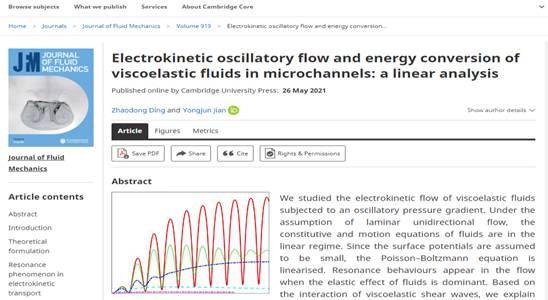Electrokinetic effect is a general term for a series of phenomena called electrically-driven motion of fluid that have been discovered since 1807 and which happens on the solid-liquid interface. The effect is widely applied in such fields as industrial production, material’s separation, purification and testing and water purification. The research team led by Prof. Jian Yongjun with the School of Mathematical Science of IMU has been concentrated on the study of nanoscale fluid mechanics, non-Newtonian fluid mechanics, hydrodynamics, hydrodynamic stability and heat-mass transfer. The characteristics of the research conducted by the team is to give the solutions to some mechanics problems and explain some practical questions related to physics and mechanics with the analysis and numerical simulation in mathematics and establishment of the proper mathematics and mechanics model of partial differential equation. In recent years, the research team has made some theoretical and practical achievements.
Energy is an important factor that affects the economic growth and the quality of life of human beings. The search for and development of clean energy is no doubt vital for the sustainable development of human society. In recent years, nanopore-nanochannel energy conversion system which is based on elektrokinetic effect, has attracted wide attentions of researchers because it is structurally simple and can effectively convert fluid mechanical energy into electrical energy. If power is generated in the traditional way, a large amount of energy will be consumed to rotate the large mechanical parts during the conversion of energy. While nanopore-nanochannel energy conversion system has a simple structure, kinetic energy can be converted into electrical energy only with a nanopore and nanochannel of charged surface, electrolyte solution and pressure gradient. Moreover, it will not cause new environmental problems and is clean and environment friendly. It is expected that the nanopore-nanochannel energy conversion system based on elektrokinetic effect will be applied in such fields as parts of micro-mains, self-driving nano machines, micro-electro-mechanical system and wearable devices, which provides new choices for the power generation system for clean energy. In 2019, the research team led by Prof. Jian Yongjun published in Journal of Fluid Mechanics an article named “Electrokinetic energy conversion of two-layer fluids through nanofluidic channels, (vol. 863, 1062–1090)”, in which the team makes a detailed analysis of the electrokinetic energy conversion efficiency of two-layer fluids through nanofluidic channels(Ding Zhaodong, associate professor with the School of Mathematical Science is the first author of the article and Prof. Jian Yongjun the correspondence author.). A lot of studies indicate that the energy conversion efficiency of nanopore-nanochannel energy conversion system based on electrokinetic effect is low, which limits the wide application of the system as power supply device. And the studies show that the efficiency of electrokinetic energy conversion can be greatly improved theoretically with viscoelastic Maxwell fluid as flow medium.
Recently, Jian Yongjun-led research team has published another article in Journal of Fluid Mechanics(2021, vol. 919, A20), a top international journal for fluid mechanics and the article is named “Electrokinetic oscillatory flow and energy conversion of viscoelastic fluids in microchannels: a linear analysis” and its first author is Associate Professor Ding Zhaodong and correspondence author Jian Yongjun. With multi-mode viscoelastic Oldroyd-B fluid model which is closer to real situations, the article makes a complete analysis of the internal mechanism of viscoelasticity in improving the efficiency of electrokinetic energy conversion from the perspective of viscoelastic shear wave. In particular, through theoretical analysis, the article finally derives a critical Deborah number(a ratio value between viscoelastic fluid relaxation time and characteristic time of shear flow field): Dec = 1/4. When the critical Deborah number is above Dec, viscoelasticity will greatly improve the efficiency of energy conversion. Otherwise, viscoelsticity will not effectively improve the energy conversion efficiency.

Further studies show that the above-mentioned critical Deborah number is in a sense universal, i.e. based on the definition of a critical Deborah number---a ratio of surface of nanochannel to its volume, the critical number can be applied to nanochannels with different sections. The research result has been published in Physics of Fluids, a top international fluid mechanics, and named “Resonance behaviors in periodic viscoelastic electrokinetic flows: A universal Deborah number”(2021, vol. 33, 032023). Ding Zhaodong, associate professor, is the first author of the article and Jian Yongjun, the correspondence author.
Journal of Fluid Mechanics is one of the core journals founded by George Batchelor, a very famous fluid dynamicist who has been with Cambridge Press University Press and a Top 1 journal in the field of traditional fluid mechanics. About 700 articles are published in the journal annually and its effect factor in 2019 is 3.354.
The above research is financially supported by the project of National Natural Science Foundation of China, the project of National Natural Science Foundation of China for Youth, the Inner Mongolia Grassland Elite Project and the project of Natural Science Foundation of Inner Mongolia Autonomous Region of China.
URL: https://www.doi.org/10.1017/jfm.2021.380.
https://www.doi.org/10.1017/jfm.2019.6
https://doi.org/10.1063/5.0046861

